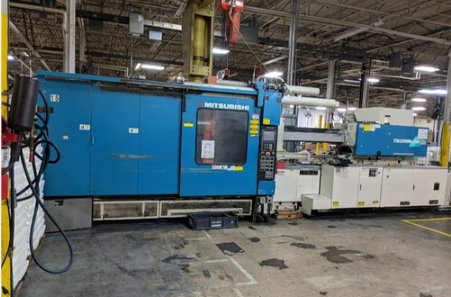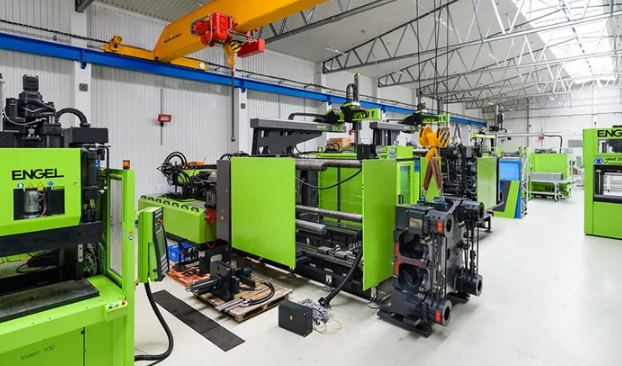Injection molding uses hydraulic, electric, and hybrid machines for various production needs.
Types of Injection Molding Machines
Injection molding machines are pivotal in the manufacturing industry for producing plastic parts. There are various types of these machines, each with unique features, advantages, and limitations.

Hydraulic Injection Molding Machines
Hydraulic injection molding machines have been the traditional choice in the industry.
Power Consumption: These machines often require significant power, approximately 15-30 kW, depending on the size and complexity.
Cost Efficiency: They are generally less expensive to purchase than electric machines, making them a cost-effective solution for many manufacturers.
Performance: Hydraulics are known for their robust performance, especially in producing larger parts.
Speed: The cycle times tend to be longer compared to electric machines due to slower movements.
Maintenance: These machines require regular maintenance of the hydraulic system to ensure longevity and efficiency.
Electric Injection Molding Machines
Electric injection molding machines represent modern technology in the field.
Power Consumption: They are more energy-efficient, often consuming 50-70% less energy than hydraulic machines.
Precision and Speed: Electric machines offer greater precision and faster cycle times, enhancing productivity.
Maintenance: Lower maintenance requirements compared to hydraulic machines due to fewer moving parts.
Cost: Initial investment is higher, but long-term operational costs are reduced due to energy efficiency and lower maintenance needs.
Noise Levels: These machines operate more quietly, improving the working environment.
Hybrid Injection Molding Machines
Hybrid injection molding machines combine the best of hydraulic and electric types.
Power Consumption: These machines offer improved energy efficiency over purely hydraulic machines.
Cost Efficiency: They strike a balance between the initial cost of electric machines and the robustness of hydraulic machines.
Performance: Hybrids provide good performance for a wide range of applications, combining speed, power, and energy efficiency.
Flexibility: Suitable for various manufacturing needs, offering flexibility in terms of size and functionality.
For more detailed information about injection molding machines, a visit to Injection Molding Machines – Wikipedia would be insightful.
Components of Injection Molding Machines
In the realm of injection molding, various critical components work together to ensure the effective production of high-quality plastic parts. Let’s explore these components in detail, emphasizing their unique roles and characteristics.
Clamping Unit
Firstly, the clamping unit plays a pivotal role in the molding process.
Main Function: It securely holds and closes the mold during the injection and cooling stages.
Vital Statistics: Clamping force can range from a modest 5 tons to a massive 6,000 tons, adapting to different part sizes.
Mechanism Types: Typically, these units utilize either toggle or hydraulic mechanisms.
Significant Impact: The clamping force is crucial; inadequate force leads to defects, compromising product quality.
Injection Unit
Next, we focus on the injection unit, the heart of the molding machine.
Core Components: This unit comprises a hopper, barrel, heater, and screw.
Power Dynamics: Heating power can reach up to 20 kW in larger machines.
Pressure Parameters: Injection pressures often exceed 2,000 bar for precision molding.
Efficiency Key: The unit’s ability to precisely inject material determines the consistency and quality of the molded product.
Mold System
Subsequently, the mold system comes into play, shaping the plastic into the final product.
Construction Material: Molds are usually crafted from steel or aluminum, each offering distinct benefits.
Design Intricacies: The complexity of the mold design varies based on the product’s requirements.
Cost Consideration: While high-quality molds are a significant investment, they are fundamental for precise part production.
Control System
Finally, the control system is an indispensable component of the injection molding machine.
Crucial Role: It manages machine operations, ensuring accurate control over all the process variables.
Advanced Features: Modern systems include real-time monitoring for optimal machine performance.
Production Influence: Effective control is vital for reducing waste, improving cycle times, and ensuring product consistency.
Delving deeper into each component’s functionality, as detailed in Injection Molding Machines – Wikipedia, can provide further valuable insights.
Specialized Injection Molding Machines
In the dynamic field of injection molding, specialized machines like multi-material and high-speed/precision machines have revolutionized the production capabilities. Here’s a comparative analysis of these advanced machines:
| Feature | Multi-Material Injection Molding Machines | High-Speed/Precision Injection Molding Machines |
|---|---|---|
| Primary Function | Can inject multiple materials into a single mold. | Focus on rapid cycles and precision for intricate parts. |
| Typical Power Usage | Ranges from 15 kW to 40 kW, depending on size and complexity. | Generally requires 20 kW to 50 kW, catering to high-speed operations. |
| Cost Implication | Higher initial cost due to complex design, but offers cost-saving in multi-component production. | High initial investment, offset by gains in speed and precision for large-scale production. |
| Operational Efficiency | Increases production efficiency by combining different materials in one cycle. | Significantly reduces cycle times, enhancing overall throughput. |
| Size and Specification | Larger in size due to additional injection units. | Compact designs are common, focusing on speed and precision. |
| Lifespan and Durability | Comparable to standard machines, but requires more maintenance due to complexity. | Often have a longer lifespan with consistent performance, subject to regular maintenance. |
| Advantages | Enables production of complex parts with varied materials, reducing assembly requirements. | Ideal for industries requiring high volume and precision, like electronics and medical devices. |
| Limitations | Increased complexity can lead to higher maintenance and operational costs. | The focus on speed and precision might limit material compatibility and part size. |
For more detailed information about these specialized machines, exploring related articles on Injection Molding – Wikipedia can be highly informative.
Auxiliary Equipment in Injection Molding
Auxiliary equipment in injection molding plays a vital role in enhancing the efficiency and quality of the production process. Let’s delve into the specifics of the key types of auxiliary equipment used.

Material Handling and Drying Systems
Material handling and drying systems are essential for preparing the plastic resins before the injection process.
Function: These systems transport and dry the plastic materials, ensuring they are in the optimal state for molding.
Power Usage: Typically, dryers consume about 3-15 kW, varying with capacity and type.
Cost Efficiency: While adding to initial setup costs, they significantly reduce material waste and improve product quality.
Operational Benefits: Properly dried materials prevent issues like moisture-related defects, enhancing overall part quality.
System Varieties: Include hopper loaders, pneumatic conveyors, and different types of dryers (desiccant, compressed air, etc.).
Mold Temperature Controllers
Mold temperature controllers precisely regulate the temperature of the mold, a critical aspect of the injection molding process.
Role in Production: They maintain a consistent mold temperature, crucial for part quality and cycle times.
Energy Consumption: Ranges from 6 kW to 20 kW, depending on the system’s capacity and complexity.
Cost Factor: Investing in high-quality temperature controllers can significantly improve product quality and reduce cycle times.
Temperature Range: Typically, they can control temperatures up to 300°C, with precision control within ±1°C.
Types: Water-based and oil-based temperature controllers, each suited for different temperature ranges and applications.
Precise temperature control is instrumental in achieving optimal molding conditions and high-quality parts.
Part Removal Robots
Automation in part removal is achieved through robots, enhancing the efficiency and safety of the injection molding process.
Functionality: These robots efficiently remove and handle parts from the injection molding machine.
Power Requirements: Generally low, around 2-5 kW, as they operate on efficient servo motors.
Investment and Return: While increasing the initial investment, robots reduce labor costs and improve cycle times.
Capabilities: Ranging from simple pick-and-place actions to complex manipulations based on part geometry.
Safety and Productivity: Robots contribute to workplace safety and ensure consistent and damage-free part handling.
For a comprehensive understanding of auxiliary equipment in injection molding, consider exploring resources like Injection Molding Auxiliary Equipment – Wikipedia.




